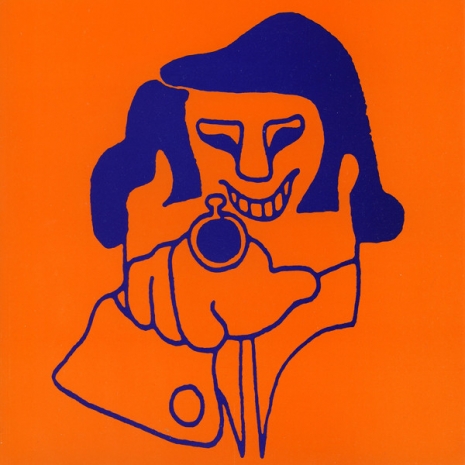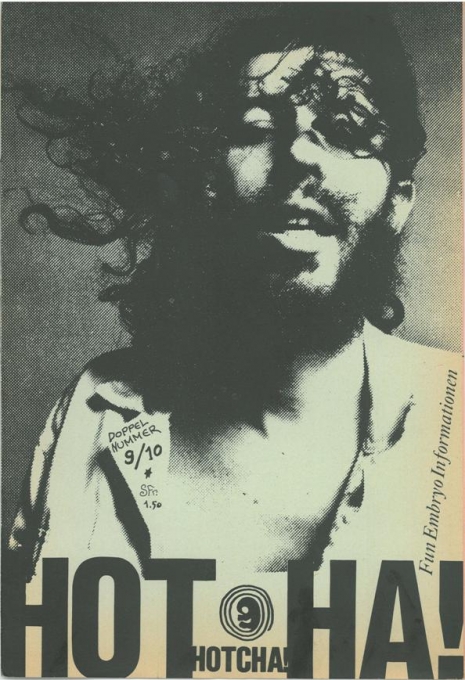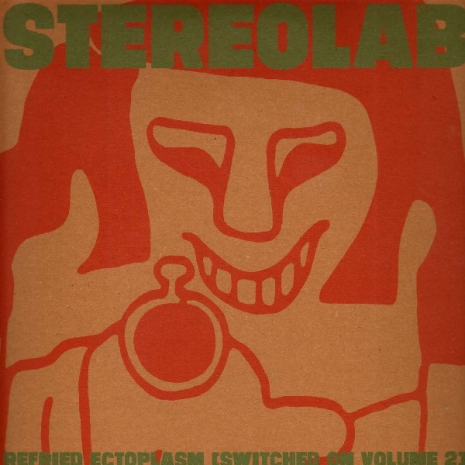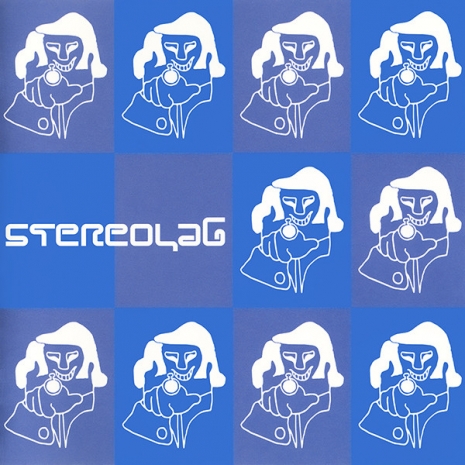
“Stunning Debut Album” 7-inch, 1991
If you’re into Stereolab, you’re almost certainly aware of the odd, grinning cartoon character who stared out accusatorially at the viewer on the cover art of many of Stereolab’s early releases. That weird little dude—gal?—was featured on Peng!, the groop’s first album, and the two important early compilations Switched On and Refried Ectoplasm (Switched On Volume 2) (Refried Ectoplasm is the best thing Stereolab ever put out, IMO) as well as a bunch of early singles.
Indeed, if you were following Stereolab in their first couple of years, that character constituted almost all of the band’s visual image up until the 1993 release of The Groop Played “Space Age Batchelor Pad Music”, which cannily repurposed the cover design of a series of Vanguard releases of “stereophonic demonstration discs” featuring French conductor Vladimir Golschmann interpreting the works of Dvořák and Tchaikovsky, among others.
The Stereolab gang apparently referred to the little fellow as “Cliff,” as was revealed in a super-early interview with the band that Chickfactor did in 1993:
Chickfactor: where did you get the image of the guy with the gun? what made you give it up on space age bachelor pad?
Tim Gane: “cliff” (as well call him) was taken from a swiss political comic from 1969. he’s a figure of the establishment who is eventually shot by the forces of the revolution (peng!). the recent mini LP [the Groop Played etc.] was based on a hi-fi stereo sound effect record of the early/mid-60s. the record doesn’t sound like that but I just like that kinda cool image shit. all of the next records will be based on the sleeves of hi-fi/stereo effect records. it’s a juvenile thing. I like themes running through the records, things that connect them together so that we can have our own “blue” period and “op art phase.”
Not surprisingly, the Stereolab gang were up on their shit. “Cliff” indeed was derived from a cartoon by Antonholz Portmann that appeared in a 1970 issue of Hotcha, an underground newspaper that was based out of Zurich. Most of the sources I’ve seen say 1970 instead of 1969, but there’s rather little out there on the subject, so anything’s possible. Hotcha looks incredibly cool, actually, similar in spirit to the International Times and Oz and a hundred other independent periodicals from the period. Here’s a typical cover, featuring Tuli Kupferberg of the Fugs:

Hotcha was founded in 1968 by a writer named Urban Gwerder with the subtitle “Fun Embryo Information.” It lasted until 1971, and during its brief existence more than 60 stimulating issues were published. Hotcha was a major player in the international independent press movement, publishing original material by Kupferberg, R. Crumb, Gilbert Shelton, Gary Snyder, Ed Sanders, and Frank Zappa, among many others. This page has some excellent scans of Hotcha issues.
Sometime in 1969 or 1970 Hotcha ran a single-page comic called “Der tödliche Finger” (The Deadly Finger) by Antonholz Portmann. It’s worth pointing out here that “Antonholz” is a made-up name, it’s a combination of the German version of Anthony (Anton) and the German word for “wood,” which is Holz. So clearly Portmann used it as a pen name. Here’s the comic—the translation provided at the bottom is perfectly serviceable:

As you can see, the image of the grinning face hardly changes, but the accusing finger slowly mutates into a loaded pistol, which goes off (Peng!) in the last panel. Gane’s words quoted above imply that the character is the so-called “figure of the establishment” who is executed at the end of the strip, but the way I interpret the cartoon, that establishment figure is off-screen, the figure Gane calls “Cliff” is the youthful judge, jury, and executioner representing the ‘68 generation staunchly opposed to militarism, conformity, bourgeois values, and so forth.
Stereolab used the final panel for Peng! and Peng! alone, for obvious reasons, and occasionally used the first panel, with the naked finger, but the image used most often was the third panel, I think (it’s actually hard to tell sometimes).
Some years later Portmann was contributing to another Gwerder-run zine called Hot Raz Times, as this page attests.
Just for the record, here’s a thorough accounting of all the variations of “Cliff” Stereolab went through over the years. The main period for that image is 1991 to 1995, although he does pop up on a Japanese sampler in 1998.

”Super Electric” 10-inch, 1991

Super 45 10-inch, 1991

Switched On comp, 1992

Switched On comp (Brazilian reissue)

”Low Fi” 10-inch, 1992

“Harmonium”/“Farfisa” 7-inch, 1992
_1992_465_465_int.jpg)
”The Light That Will Cease to Fail” 7-inch (pink wax), 1992
_1992_465_463_int.jpg)
“The Light That Will Cease to Fail” 7-inch (yellow wax), 1992

Peng!, 1993

“French Disko” 7-inch, 1993

“John Cage Bubblegum” 7-inch, 1993

Refried Ectoplasm (Switched On Vol. 2) comp, 1995

“French Disko”/“Super Electric” promo CD single, 1995

Stereolab Sampler (Japanese comp), 1998
After all of that, you deserve to hear a little Stereolab music, so here’s “John Cage Bubblegum,” one of the heaviest tracks the groop ever put out:
Previously on Dangerous Minds:
Is Stereolab the best soundtrack for a blow job? Pharrell thinks so!